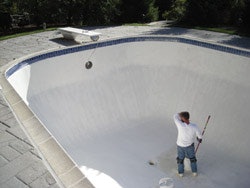
And when that fiscally conscious but proud home owner sees chipped paint, peeling or missing plaster and massive discoloration, despite the uncertainty of the times, he or she has remained generally willing to part with the cash to make it smooth and bright again.
AQUA caught up with three refinishers who have been in the business for a while, through good times and bad, and who know what it takes to make a pool look like new again.
The Pool And Spa Store
At The Pool And Spa Store, Mocksville, N.C., they do it all - retail, service, new pool construction and renovation. As part of company's comprehensive pool business, co-owner Ken Kitchel has been building and replastering custom gunite pools since 1989. After years of working wtith traditional plaster, about seven years ago he developed an appreciation for Sider-Proof by Sider-Oxydro, which has become a mainstay of the refinishing portion of his business:
"What I like about this product is you don't have to have a big pump truck out there to spray it; and you don't have to do all your mixing on the back of a truck - I did that for years - dragging out all the hoses and so forth. You can just apply this stuff out of the back of a pickup. It's pretty easy.
You just mix everything up in 5-gallon buckets, it rolls on, and you smooth it with a "magic trowel" - it's something like a squeegee, and a lot easier to use than a regular trowel. It's like icing a cake.
Three of us put it on - me and two other guys. One guy mixing, one guy rolling and one guy troweling. In the past, I'd have a guy spraying a gun, a guy feeding that mix, a couple of trowelers in the pool and a couple of guys with shovels.
The advantage is that it cuts the labor time down, and you don't have to have experienced trowelers on hand. It allows pool guys that aren't professional trowelers or don't have them in their crews to increase their business. It adds a new facet to the pool guy's repertoire, to help bring money in. And let's face it, we have to do what we can to bring money in. This year we've been blessed by God, we still have pools on the board to build, and we've got a YMCA and several hotel pools that we're resurfacing.
What I hear from customers is that it's a much cleaner job site and much less time involved to do it.
Underwater Pool Masters
Underwater Pool Masters, a service company in West Boylston, Mass., does a variety of pool finishes, from plaster to paint, depending on customer preference. When a project demands a paint finish, he likes Ultra Poly One Coat from Poly Solutions because he finds it particularly easy to work with. Steve White, president of Underwater Pool Masters, has been in the pool business for over 30 years, mostly doing renovations. He is a CPO instructor and a Certified Service Professional.
"Over the last 30 years I've used almost every product. I started using epoxy paints after a while, but the environmental hazards bothered me and my crew. They've got VOCs and the fumes are very caustic to work with, particularly on an indoor commercial pool. You might be in a hotel or perhaps a country club, and the fumes would almost drive the people out. You'd have to have special ventilation. And often my employees would start feeling ill by the end of the day.
When I started with Ultra Poly One Coat, I was particularly pleased with the fact that it was pretty much odorless. We did many renovations indoors (and outdoors of course) and we didn't have any occasion where fumes were a problem. Nobody got lightheaded or affected by working with the product. So we tended to like it. There are no VOCs in it. So that's what I like about it; it's safe and easy to work with.
We've used it for six years. It dries relatively fast in a well-heated, low-humidity environment.
When you're applying it, it's important to keep an eye on how fast it's hardening. That's its pot life - the amount of time you have, once you mix it up, before the paint is cured.
If you don't present the paint to the surface within this pot life, the rollers get stiff and you can't apply it anymore. If we leave it overnight in a bucket, it's absolutely hard the next day.
It's a heat-dependent reaction; it cures fast when it's hot, and it slows down in a cold environment. One of the tricks we've learned to use is if I'm working by myself, what I do is take the container of paint and put it in a pool of icewater, and that cools the paint and extends the curing time.
With any coating or finish, though, it's only as good as the surface it goes on, how careful you follow the manufacturer's instructions and especially the water chemistry of the pool after you're done.
That's one thing I cannot stress enough in refinishing pools - and that goes for every pool surface, not just plaster and paint but even fiberglass and vinyl liner, because we deal with all of them - the importance of water chemistry. It is the key to the longevity of the new surface we put on.
If you put that new surface on right, and then you get a call from that customer two or three years later saying, "Hey, I'm having trouble with my pool surface," that's almost always a water chemistry problem. I've seen people try to save two or three hundred dollars worth of chemicals and mess up a pool finish worth thousands of dollars.
Gardner Pool Plastering
Gardner Pool Plastering, based in San Diego, is one of a select group of Pebbletech refinishers across the U.S. About half the pools that Gardner does are regular plaster, and Pebbletech is the company's exposed-aggregate option, says company president Scott McKenna:
"The two important points about exposed aggregate are that it's going to last indefinitely, and it's beautiful. Exposed-aggregate is much more durable because 90 percent of the surface is stone, which is much less affected by water chemistry and sun than a surface that is purely sand and cement. At the same time, it's a natural-looking finish. All of the aggregate stone is either out of the ocean or a river, so it's naturally tumbled. It's not sharp.
Compared with a plaster finish, it requires a lot more equipment and manpower and uses a much different process. With plaster, of course, you pump it in, trowel it and you're done. But with Pebble, you pump the concrete in and trowel it, and just like when you're finishing concrete, it brings all the fines to the surface. Then we take high-pressure wands and wash the fines off the surface, and it leaves exposed aggregate. When you wash those off, you're exposing the stone underneath it. That's all exposed aggregate is.
We go through this process several times, where we trowel it again, bring all the fines to the surface again, and then wash away the fines, until we have a really nice even, exposed-aggregate surface, and then we clean up, come back the following day, and do an acid wash and polish. Then we fill it back up with water.
So it's a much more involved process, and the material is more expensive, and the process takes more time and is more labor intensive, but it's a more expensive finish, and that can help your margins.
When you're done it's a much more forgiving product because it's rock and it varies in color, so all the imperfections are well hidden, as opposed to a plaster job, where people almost expect it to look like paint when your done, and be all even in color.
We do both new pools and renovations. New pools are way down, but the remodeling has been pretty steady for us. Hasn't decreased much at all in the last three years or so. The ratio is much higher, remodel to new, because new pools are down.
Comments or thoughts on this article? Please e-mail [email protected].







































